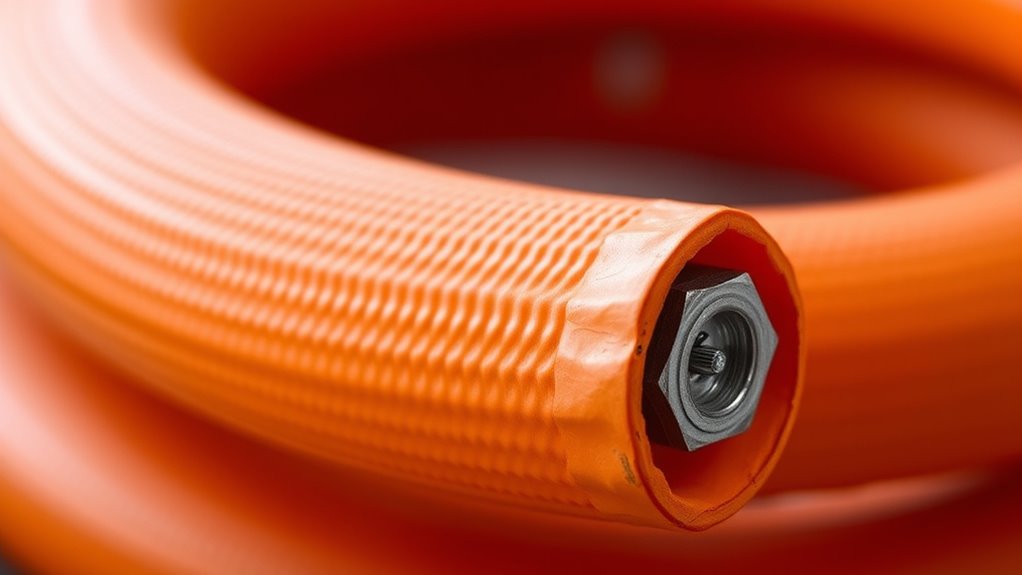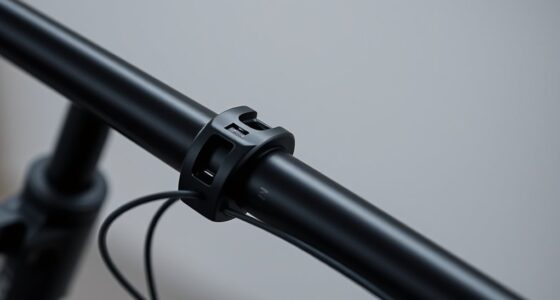To shorten a hydraulic hose, first inspect it for damage and verify it’s in good condition. Carefully depressurize the system by disconnecting the hose and releasing any residual pressure. Use a sharp utility knife or cutter to make a clean, straight cut at the desired length. Then, attach new fittings securely using proper tools and double-check their tightness. To ensure safety and proper function, follow these steps closely—if you want to know more, keep going.
Key Takeaways
- Assess hose condition and determine if shortening is necessary due to damage or excess length.
- Fully depressurize the hydraulic system and wear protective gear before disconnecting the hose.
- Use a sharp, clean tool to make a straight cut at the desired length, then inspect and trim if needed.
- Attach new fittings with proper crimping tools, ensuring secure and leak-proof connections.
- Reconnect the hose, repressurize gradually, and check for leaks or irregular operation before regular use.

If your hydraulic hose is too long or has become damaged, shortening it can improve system performance and safety. A hose that’s too lengthy can cause unnecessary slack, leading to cluttered machinery, restricted movement, or even kinks that hinder fluid flow. Damaged hoses pose safety risks, such as leaks or bursts, which can result in injuries or equipment damage. When considering shortening a hydraulic hose, it’s vital to approach the task carefully, following proper procedures for hose replacement and safety precautions.
Start by inspecting the hose thoroughly to determine if shortening is necessary. If the hose is in good condition but simply too long, you can cut it to the desired length. However, if the hose shows signs of wear, cracks, or leaks, replacing the entire hose might be a safer choice. Always prioritize safety precautions during this process. Wear protective gloves and eye protection to guard against hydraulic fluid exposure, which can be harmful or cause irritation. Make sure the system is depressurized before working on the hose to prevent sudden fluid release that could cause injury. Disconnect the hose from the system carefully, and ensure residual pressure is fully relieved before proceeding.
When cutting the hose, use a sharp, clean utility knife or a specialized hose cutting tool designed for hydraulic hoses. Make a straight, clean cut to ensure proper sealing when attaching a new fitting or coupling. After cutting, inspect the cut end for any fraying or damage, and trim if necessary. To reattach or replace the hose, choose the appropriate fittings that match the hose’s specifications. Use a proper crimping or fitting installation tool to ensure a secure connection. A loose or improperly fitted hose can lead to leaks or system failure, so double-check your work.
Additionally, considering the color accuracy of the new fittings and hoses can help ensure proper visual inspection and maintenance over time. After completing the hose shortening or replacement, always perform a thorough safety check. Reconnect the hose to the system and slowly re-pressurize it, watching for leaks or irregularities. Conduct a test run to verify the system operates smoothly without leaks or unusual noises. Proper hose replacement and shortening not only improve hydraulic system performance but also reduce safety risks. Remember, if you’re unsure about any step or if your hose shows significant damage, it’s best to consult or hire a professional. Properly shortening or replacing hydraulic hoses is a precise task that demands attention to detail and adherence to safety precautions. Doing it right ensures your equipment runs efficiently and keeps you safe during operation.
Frequently Asked Questions
Can Hydraulic Hoses Be Shortened Without Special Tools?
You can’t shorten a hydraulic hose without special tools because doing so requires precise cutting and re-assembly. The hose material and compatibility concerns are vital—you need the right tools to avoid damaging the inner lining or compromising pressure ratings. Attempting to cut it with basic tools risks leaks or failure. Always use proper hydraulic hose cutters and fittings to guarantee safety, longevity, and peak performance.
Will Shortening Affect the Hose’s Pressure Rating?
Shortening a hydraulic hose can affect its pressure capacity and hose integrity if not done properly. When you cut the hose, you risk weakening its structure and reducing its ability to handle high pressure. To maintain safety and performance, you should use proper tools, fittings, and follow manufacturer guidelines. Otherwise, the hose may fail under pressure, risking damage or injury. Always prioritize professional assistance for modifications.
How Long Does a Hydraulic Hose Shortening Process Take?
Shortening a hydraulic hose is like trimming a bonsai tree; it takes precision and patience. The process usually takes about 30 minutes to an hour, depending on your hose material and the effectiveness of your shortening tools. You’ll need to carefully measure, cut, and reattach fittings, ensuring the hose stays durable and safe. Rushing can jeopardize the pressure rating, so take your time and double-check your work.
Is It Necessary to Replace Fittings After Shortening?
You don’t always need to replace fittings after shortening a hydraulic hose, but fitting replacement is recommended if the existing fittings aren’t compatible with the new hose or show signs of damage. Ensuring hose compatibility with the fittings is essential for a secure, leak-free connection. Always inspect fittings carefully, and if there’s any doubt about their condition, replace them to maintain safety and maximum performance.
Are There Risks of Leaks After Shortening a Hydraulic Hose?
You risk leaks after shortening a hydraulic hose if you don’t follow proper safety precautions. Studies show that improper fittings or damaged hose material can cause leaks in up to 15% of repairs. To prevent this, confirm you use compatible fittings and inspect the hose material carefully. Always follow safety precautions, like securing connections tightly and testing the system before use, to minimize leak risks and maintain safe operation.
Conclusion
Just like a master gardener trims away excess branches to help a tree flourish, shortening your hydraulic hose guarantees it performs at its best without tangles or slack. By carefully cutting and reattaching, you’re nurturing your equipment’s health and longevity. Remember, each precise cut is a step toward a more efficient, reliable system—turning a simple task into a skillful act of maintenance, much like tending a thriving garden that blooms with strength and resilience.









